
Each year, the American College of Sports Medicine (ACSM) releases its Top 10 Fitness Trends. With wearables, group training and high-intensity interval training (HIIT) topping the list, it is sure to have an effect on campus recreation. Let’s take a look at the top 10 trends for 2020 and how they integrate with our campuses.
1. Wearable Technology
What is it?
Wearable technology first appeared on the Top 10 list in 2016 and hit the No. 1 spot. After remaining No. 1 in 2017, it dropped to No. 3 in 2018, went back to No. 1 in 2019 and it’s here to stay. Wearable technology includes any fitness trackers, smartwatches, heart rate monitors, and/or GPS tracking devices.
What does it mean for Campus Recreation?
Our students, faculty/staff, and members are more vested in their own behaviors and habits than ever before. Wearable technology can increase self-efficacy in our members and it is no longer an added value, it’s an expectation. Find creative solutions to incorporate wearable technology in your programs whether they are structured, self-directed or even virtual. Many physical education and activity courses are even moving to a hybrid or complete online model with the use of wearables.
2. High-Intensity Interval Training (HIIT)
What is it?
HIIT training are exercise programs that consist of short bursts of high-intensity efforts followed by short periods of rest. Although sustained efforts of more than 90% maximum effort can cause potential injuries or other hazardous effects, HIIT isn’t going anywhere. HIIT hit the trends report, for the first time ever, strong in 2014 at the No. 1 spot and hasn’t left the top five since.
What does it mean for Campus Recreation?
HIIT is becoming a bread and butter of our operation whether we provide structured HIIT opportunities or our clientele participate self-directed. Education to our staff is essential for HIIT. It needs to become a part of our staff training programs, onboarding and continuing education. Remember true HIIT training is 30 minutes or less; if you are able to sustain HIIT training in excess of 30 minutes then you aren’t doing HIIT.
3. Group Training
What is it?
The term group training can be quite confusing. In 2019, ACSM did not separate large group training and small group training on the worldwide trends survey; therefore, in this case, group training is intentionally designed, in-person movement classes led by an instructor for groups of five or more participants. Small Group Training can still be considered to be in this category, but remember, small group training is back-of-house terminology for programs like HIIT, etc.
What does it mean for Campus Recreation?
Group exercise programs aren’t going anywhere. What we consider to be group exercise is going to continue to evolve; the outcome won’t change but the pathway will. We need to be delivering memorable movement experiences that cause our participants to miss us when they aren’t there. Live, in-person classes aren’t going away, but we need to start implementing virtual programs that reach people where they are.
4. Training with Free Weights
What is it?
Training with free weights showcases that instructors and trainers teach participants proper form with the use of barbells, dumbbells, kettlebells and/or medicine balls. Resistance is increased and progressed as form is executed properly. Training with free weights hit the Top 10 list for the first time in 2020 and debuts at the No. 4 spot.
What does it mean for Campus Recreation?
We need to remember all of our clientele are typically training in one of the following four categories: health, function, fitness or performance. For those training for fitness, it’s important to progress clients away from pin-selected equipment to training with free-weight equipment when ready. Our movements in our training space should mimic the five primary movement patterns we execute in daily life: bend and lift, push, pull, single leg movement, and rotation. Consider hosting a form workshop and have your personal trainers take charge.
5. Personal Training
What is it?
Personal training is considered a one-on-one exercise program and continues to trend as it becomes more accessible with online, in-home, in-club and worksite training programs on the rise, as a large shift in personal training has moved online. The ACSM trends report began in 2006 and personal training has remained in the top 10 ever since. Personal training jumped from the No. 8 spot to the No. 5 spot for 2020.
What does it mean for Campus Recreation?
Personal training is changing and so should we. Think about offering online programs, moving toward a membership model with personal training, and having more than one trainer work with a single client. Read more about the changes in personal training by checking out this blog post.
6. Exercise is Medicine
What is it?
According to ACSM, “Exercise is Medicine (EIM) is a global health initiative that encourages health care providers to include physical activity assessment and associated referrals to certified fitness professionals in the community as part of every patient visit.” In addition, EIM recognizes fitness professionals as part of the health care team in their local communities. EIM took the biggest jump for 2020 and went from No. 10 to No. 6 on the list.
What does it mean for Campus Recreation?
Exercise is Medicine will continue to rise. Take advantage of the access to relationships on campus with your health center and/or medical schools if you have one. Keep the conversations moving to see what it takes to implement a referral program on your campus.
7. Body Weight Training (BWT)
What is it?
BWT hit the top 10 trends report in 2013 and hasn’t left yet. BWT is a combination of variable resistance and neuromotor movements in all planes of movement utilizing the body as a machine. It uses minimal equipment and maximizes workout effectiveness. It can also be argued as the most affordable way to train.
What does it mean for Campus Recreation?
I’ve said it once and I’ll say it again. Simply put: less equipment, more open space.
8. Fitness Programs for Older Adults
What is it?
This trend emphasizes the need for offering programs for baby boomers and the active aging generation. In general, people are living longer, healthier/active lives, working longer, and potentially have more discretionary funds to spend.
What does it mean for Campus Recreation?
We may see our faculty/staff work longer in their careers and see an increase in their membership and engagement with us. We are also seeing an increase in the “non-traditional” student which can increase the age diversity of our typical member. When creating programs for your campus rec department to offer, consider who your ideal member is for that program and ways to be inclusive of all age groups. Look for opportunities to partner with your community on programs like Silver Sneakers when your foot traffic is typically lower.
9. Health/Wellness Coaching
What is it?
This trend incorporates behavioral science into health promotion and lifestyle medicine programs. Health and wellness coaching can be delivered in a one-on-one or small group setting both in-person and online. It’s based on motivational interviewing and a practical application of health behavior theory. Health and wellness coaching has been in the top 20 since 2010.
What does it mean for Campus Recreation?
I can confidently say that health and wellness coaching needs to be close to the top of your priority list in campus recreation. Mental health is continuing to be a top concern on our campuses and our helping professionals, like counseling centers, are often understaffed and overbooked. Take time to build relationships on how you can help each other. Find out why people are falling into the river and try to prevent them from doing so. There’s no time for territory wars when it comes to health and wellness coaching because the well-being of our students and community is everyone’s responsibility.
10. Employing Certified Fitness Professionals
What is it?
Employing certified fitness professionals replaced the broader term prior to 2019 which was “educated, certified and experienced fitness professionals.” Hiring certified health/fitness professionals through accredited education programs and certifying bodies is more important than ever. The National Commission on Certifying Agencies (NCCA) allows employers to easily validate employees’ certifications along with the US Registry of Exercise Professionals (US Reps).
What does it mean for Campus Recreation?
If we say we prepare our students for their future, then we need to actually do so. We should be offering educational and certification programs on our campuses that prepare our students to sit for group fitness, personal training, and/or health coach certification exams. Most educational partnerships are offered at no cost to the Campus Recreation department, and students receive extensive discounts to the certifications. With the rise of US Reps, it’s more important than ever fitness facilities are hiring credentialed health and wellness professionals.
Conclusion
The ACSM Worldwide Survey of Fitness Trends is always one of my favorite reports to read each year. It always sparks interesting discussion and often we will rebuttal, in many online social media platforms, why something popular in an area didn’t make the list. Just because there is regional popularity on something doesn’t always mean it’s an international trend. Campus Recreation departments need to stay in the know of what’s happening around the world with movement trends. Our goal is to prepare our students for success beyond college so we would be doing them a disservice by not preparing them for what’s actually ahead. As we embark on this new decade, how will you create change?










